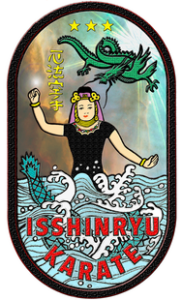 One afternoon Master Shimabuku was teaching in the courtyard of his home in Agena. There was a tank in the yard that he used to collect rainwater for his thirsty students and to safeguard his family in case of drought. After a full day of teaching, Master Shimabuku sat atop the tank to enjoy a cup of tea and perhaps a little bit of Sake. As he began to relax from the toils of the day, he soon fell asleep and began to dream. In his dream, a man entered the courtyard and approached him. Suddenly, the man challenged Shimabuku to a fight, but instead of accepting the challenge, Master Shimabuku waved the man away with his left hand while clenching his right hand in a fist, should the aggressor persist. Before leaving, the stranger encircled Master Shimabuku in a ring of fire and then as mysteriously as he had appeared, he vanished.
One afternoon Master Shimabuku was teaching in the courtyard of his home in Agena. There was a tank in the yard that he used to collect rainwater for his thirsty students and to safeguard his family in case of drought. After a full day of teaching, Master Shimabuku sat atop the tank to enjoy a cup of tea and perhaps a little bit of Sake. As he began to relax from the toils of the day, he soon fell asleep and began to dream. In his dream, a man entered the courtyard and approached him. Suddenly, the man challenged Shimabuku to a fight, but instead of accepting the challenge, Master Shimabuku waved the man away with his left hand while clenching his right hand in a fist, should the aggressor persist. Before leaving, the stranger encircled Master Shimabuku in a ring of fire and then as mysteriously as he had appeared, he vanished.
Maintaining his composure, Master Shimabuku looked about, picked-up the bucket from the water tank and used it to pour water on the flames surrounding him. The flames were quickly extinguished, as was his dream, and he awoke.
The next day he had to go into Naha, the Okinawan capitol, on business. Upon entering one of the buildings there, he saw a picture on the wall of a woman waist deep in water. She was half woman and half serpent and had one hand extended in peace and the other clenched in a fist. He immediately inquired as to who the woman was and was told by the employee of the building that it was “Mizu-Gami,” the shinto water goddess. Struck with the similarity between the Mizu-Gami and the events in his dream the day earlier, he came to believe that her one open hand reflected a sign of peace but that her clenched fist represented a willingness to fight should evil persist. Furthermore, the Mizu-Gami was in water, like he was on the tank, and like he had done in his dream, she was using the water to extinguish flames. He surmised that the water, therefore, represented purity, strength and goodness; and that fire was the symbol for evil, destruction and aggression.
Ultimately, the Mizu-Gami became the central figure in the Isshin-Ryu patch, which incorporates all of Master Shimabuku’s philosophies pertaining to Karate:
strengthen the mind and body
instill self-discipline
promote self-confidence
gain a means of self-protection through constant study and practice.
The turbulent waters represent the stress and trials of life that we all face.
The grey background in the night sky represents the calm that is available to all Karate-Kas through practice and patience, and that Karate should only be used for self defense.
The dragon is a sign of good luck in eastern mythology and signifies the Karate-Ka ascending into a calm state in the face of problems through the practice of martial arts.
The dragon and the serpent both can also represent the fighting spirit one must have to overcome adversity. The three stars can either represent Shorin-Ryu, Goju-Ryu and Isshin-Ryu (mother, father and child); mind, spirit and body or simply the three Masters whom Master Shimabuku studied under: Chotoku Kyan, Choki Motobu and Chojun Miyagi.
The writing spells Isshin-Ryu. The orange ring around the outer edge of the patch stands for the ring of fire that encircled Master Shimabuku in his dream.
The oval shape of the patch represents the vertical Isshin-Ryu fist.
The Mizu-Gami is always worn over a Karate-Ka’s heart to signify the “One Heart Way.”
©2023-2024 International Isshin-ryu Karate Association